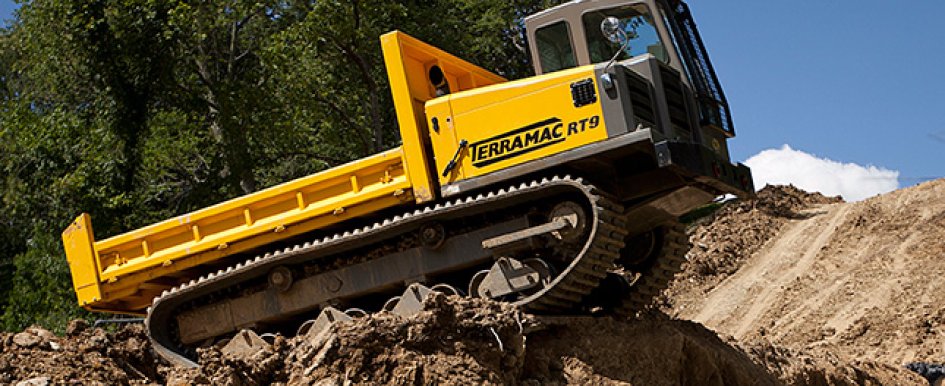
The trend for mounting site-based support vehicles on tracks increases steadily each year. Tracked carriers can have a higher cost up front, but if a tracked carrier is suited to the operation, its owner will be paid back again and again throughout the life of the carrier. How can contractors predict the return on investment that tracked carriers might yield for their operation?
Mike Crimaldi, founder and CEO of Terramac, LLC, knows the tracked carrier business inside and out. He has worked with small, tracked drills since he was 15. Before founding Terramac, he had built Rig Source Inc., a company that, for years, has specialized in selling, buying, fixing and customizing tracked drills and utility vehicles of various manufacturers.
Initial Investment
“Up front, a tracked carrier will tend to cost more than wheeled vehicles for two reasons,” Crimaldi says. “For one, they are built much more robust than, say, a utility truck because they are destined for the work site only and aren’t used for over-the-road travel. Two, they are customized for their job. For instance, many worksites require ROPS (Roll Over Protection Systems) and FOPS (Falling Objects Protection Systems) to be added to carriers, whereas wheeled vehicles chosen for the same work may not have that as an added concern.”
Maintaining a tracked carrier, Crimaldi says, costs about the same as for wheeled support vehicles. “One maintenance difference is that one has six to 10 tires and the other a set of tracks. Tracks can be a little more expensive to replace. But other than that, maintaining them is about the same.”

In general, the contractor’s return on investment will accrue over the life of the vehicle, Crimaldi says. However, in many applications, the contractor will also realize increased profitability due to more productivity and versatility. Rental houses see it in their rental income, especially contracts with longer terms of use.
Less Downtime
Comparative increases in productivity and reliability depend on what a contractor’s typical site conditions are. “Track-mounted equipment is a good investment when contractors are frequently working hills, rough terrain and wet land. Tracks have the advantage in that environment,” Crimaldi says.
Climate also plays a part. “Take spring, for instance,” he added. “When the ground is thawing, it is soft and muddy, and contractors with trucks are parked while they wait for the ground to dry up so they can get back to work. But tracked vehicles are out there working right now.”
Greater Utility
Versatility has to do with how contractors can use the tracked vehicle. “Tracked vehicles can be considered more a support utility vehicle for on-site projects,” Crimaldi points out. “If your dump truck is only being used on site, not to haul things over the road, then the tracked dumper is a better value because of the other tasks you can accomplish with it.”
For one, owner/operators are more comfortable customizing their tracked carriers than over-the-road vehicles. “Owners use them like jobsite golf carts,” Crimaldi says. “They might carry people, fuel, mulchers or have a flat bed, allowing owners the flexibility to suit their operations. What customers would typically set in the bed of a pickup can be welded right to a carrier.”
Profitability from increased versatility is hard to measure, Crimaldi says, since companies tend not to share data in a competitive market. “But I’d say we’re seeing steadily increasing growth,” he says. “As more and more companies are exposed to a tracked carrier’s versatility, they definitely are realizing they can be more profitable with it.”
Retained Value
ROI also comes from just how well carriers maintain value. “Companies vary so much in their fleet maintenance and upgrade schedules, so this is sometimes hard to calculate for comparison purposes,” Crimaldi says. So he focuses on trade-in and resale values. “The carriers hold their value well and, comparatively, have significantly longer useful lives,” he says.
“For the most part, that’s because, as work site support vehicles, they don’t see the same run times as over-the-road equipment. The operator hauls a load, moves it aside and turns it off. So they run maybe only 50 percent of the time they are at the job.”
Appearances can be deceiving, Crimaldi says. “Even though carrier exteriors take a lot of abuse over the course of their lifetime, their engines really don’t.” The result is that tracked carriers tend to stay longer in a company fleet and still sell well at upgrade time. “They stay valuable because everyone is looking for good, used equipment.”
In the final analysis, if a tracked utility vehicle will be committed to site-based operation on rough or wet terrain, it will produce a steady return on investment throughout its life in the fleet. And when it finally comes time for the owner to upgrade the fleet or remove the carrier from it, a lot of that initial investment will come back during trade-in or sale as a good, used rig.
Tips for Purchasing a Tracked Carrier
- Consider the size and carrying capacity. Tracked carriers are available in a range of sizes, so be sure to purchase one that suits your project.
- Check availability. Lead times vary between manufacturers, so if you are on a tight timeline, be sure to plan accordingly.
- Test drive. Ask the manufacturer about rental options prior to purchase.
- Check ability for customization. If you have a need for custom-mounted support equipment, discuss the details with the manufacturer before making a purchase to ensure compatibility.
- Determine ease of maintenance. In order to keep equipment in peak condition, consider choosing a carrier that has simplified daily maintenance procedures.
- Evaluate parts and service support. To maximize uptime, make sure your new tracked carrier uses readily available parts.
- Understand payment terms. Ask the manufacturer about financing and rental-purchase options (RPO).
- Consider warranty. Review the details of the standard and extended warranty.
